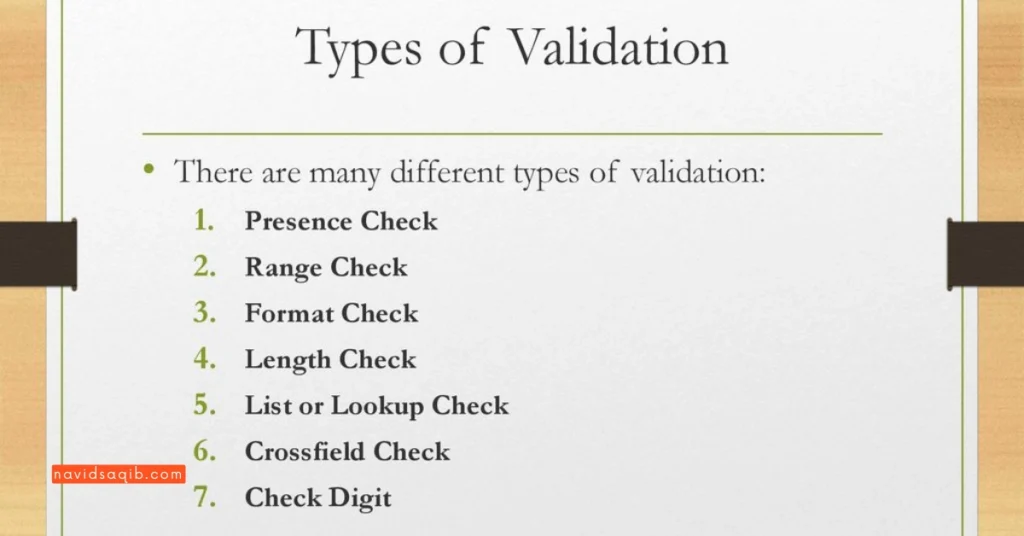
Validation Checks are an important aspect of the digital world and are crucial for every firm in terms of collecting and analyzing data for decision-making processes.
Validation checks are procedures or rules applied to ensure that data entered into a system meets certain criteria or constraints. These checks help maintain data integrity and accuracy. Right as the information is being entered, the computer runs a check.
Any data entry that does not follow predetermined guidelines is attempted to be avoided. While validation guarantees that data is comprehensive, logical, and within permissible bounds, it does not prevent inaccurate data from being entered.

Types of Validation Checks
Some of the common validation checks are mentioned below with examples:
Presence Check:
- The most basic validation technique is a presence check. Any field in a database can be subjected to a presence check, which verifies that some data has been placed into the field and that it hasn’t been left empty.
- If a field is left empty, an error message will be displayed and any additional data you have provided will not be saved or you will not be allowed to move on to another entry.
- For instance, a tailor will always want to know the date of your event.
Format Check:
- A format check verifies that the data entered follows a specific format or pattern. Using an input mask, the format that the data must be in is specified. Special characters that indicate which characters can be typed where make up the input mask.
- The special characters that make up the input mask specify which characters can be typed where.
- An example of an input mask that can be used to validate four-letter codes, and postcodes.
| Input Mask | Purpose | Valid Data | Invalid Data |
| LDLD | Four Letter Code | CADE, FOLD | CDE, FGH |
| Ll90 0LL | Postcode | WA14 9JD, MT15 6TV | WAM4 9PM, WA6 13 |
Range Check:
- A range check is performed to guarantee that the data is contained within the parameters we have established.
- There is a specified lower and higher limit for reasonable values. Any values that are not inside this range will be disregarded. Most complex databases allow you to define acceptable ranges for every field.
- Range checks are important. They help detect and prevent gross errors caused by typos, omitted decimal separators, and other common real-world data entry problems.
- In certain cases, a given field just needs one boundary. A cone, for instance, cannot be certain about its maximum volume but can have a minimum volume of zero cubic centimeters.
- For example: University students are mostly aged between 18 to 26. So by using a range check a program can be made to accept the ages that are in this range.
| Field Name | Lower Limit | Upper Limit |
| Age | 0 | 100 |
| Temperature °C | -10 | 50 |
Length Check:
- Making sure that the right amount of characters is entered into the field is verified via a length check.
- It makes sure the character you entered is the right length.
- For example, a USA landline number has 10 digits such as (555) 222-1689, where the first three digits are the “area code”. A length check can be used to make sure that only 10 digits are entered into the field.
- It is also possible to set a length check so that characters can be entered within a specific range.
- For instance, registration numbers can be in the form of, CV456 2REF (9 without a space or 10 with a space).
Type Check:
- As you start designing your new system, you’ll decide which data type is best for each field.
- A type check verifies that the data type entered is accurate.
- For instance, a field might only allow numerical input. If so, the system should reject any data that contains additional characters, like letters or special symbols.
Consistency Check:
- A consistency check is a type of data validation process that ensures data is accurate, logical, and in agreement with predefined rules or constraints.
- It verifies that the data remains consistent with the expected format, values, or relationships within a dataset or between different datasets.
- Consistency checks are commonly used to maintain data integrity and prevent errors or inconsistencies in databases and other data storage systems.
- Consistency checks can be customized based on specific data requirements and business rules, helping organizations maintain reliable data for decision-making and analysis.
- For example, you have a database table that stores information about employees, including their hire dates and birth dates. A consistency check in this scenario might involve ensuring that an employee’s hire date is always on or after their birth date, as it wouldn’t make sense for an employee to be hired before they were born.
Uniqueness Check:
- Certain data, such as email addresses or IDs, are unique. These fields should ideally have unique entries in a database.
- A uniqueness check ensures that an item is not entered multiple times into a database.
- For example, a Social Security Number is different for every person. The barcodes of different products are unique and cannot be the same for two items.
Pattern Check:
- Validates that the data entered matches a specific pattern or regular expression.
- Pattern Check is the technique that identifies specific patterns or sequences or a combination of characters within a larger piece of information.
- Pattern Check Validation enables a user to input a specific string of characters to confirm if they are present in the data string
- For instance, a user could enter the pattern 17V which is used in DI formats to identify the manufacturer’s Enterprise Identifier. If the characters 17V are present in the code, the reader will signal a pass for validation for that code. If the characters are not present, the reader will signal a failure for validation.
Referential Integrity Check:
- In database design, the term “referential integrity” refers to the connection between two tables. It is crucial because it guarantees that all of the data in a database is current and consistent.
- Referential integrity checks involve validating that relationships between tables remain intact.
- A foreign key is formed when a primary key from one table shows up in another table.
- Whenever a foreign key value is used, it must reference a valid existing primary key in the dimension or parent table.
- For example, in its simplest form, two columns that are linked between two tables, such as product identifiers in sales records, also need to be found in the product table.
Custom Validation Check:
- There may be times when you want your test to perform an action or validation that is not included in the predefined steps menu.
- Custom validations enable you to add custom business logic to enforce data rules on your applications, dimensions, node types, and hierarchy sets.
- For example, a credit card payment form may include custom validation to verify the credit card number’s checksum algorithm.
The first five checks are part of the O-level syllabus 2010, The O-level student has to understand these codes and their implementation in a procedural language either using Python VB or Java language syntax.
Each of these validation checks contributes to ensuring data quality and consistency within a system, helping to prevent errors and maintain the integrity of the data.
Significance of Validation Checks
A validation check can aid in the faster detection of issues. Additionally, it can help you later on when clearing out invalid information. Apart from this, there are various reasons why validation checks are crucial.
We’ll talk about a few of its most crucial elements in this section:
- Through data checks, analysts may reduce the amount of incorrect information in their warehouse. For the greatest effect, organizations should collaborate to validate data.
- To address any issues with the project, it is imperative to validate the data’s precision, clear thinking, and specificity. Without validating data, you run the danger of making decisions based on incorrect ineffective information.
- Data warehousing and the ETL (Extraction, Translation, and Load) process both use validation checks. It makes it easier for an analyst to comprehend the extent of data gaps.
- Testing the data model is also crucial. Data files can be used in a variety of programs and applications if the data model is properly configured and organized.
Advantages and Drawbacks of Validation Checks
Businesses may make smarter judgments and ensure the accuracy and validity of their datasets by using validation checks.

Here are the advantages and disadvantages of each if you’re considering validating data for your company:
Advantages
- Improved quality of Data: By assisting to identify and address issues early in the development phase, validation techniques can improve the overall quality of the finished product.
- Reduced development time: Using validation checks early in the development process might help minimize the chance of costly revisions down the road by identifying and addressing requirements.
- Enhanced User Participation: Involving users in the validation process can lead to increased user buy-in and engagement in the project.
- Better Communication: Using validation techniques can improve communication between stakeholders and developers, by providing a clear and visual representation of the software requirements.
Disadvantages
- Time-Consuming: Employing validation checks for a program is time-consuming and can be expensive as well.
- Threat of Conflicting Objectives: Conflicting needs resulting from the use of validation procedures can make it challenging to order and execute the requirements.
- Change in Requirements with Time: It can be challenging to stay on top of needs changes over time and make sure the project is in line with the most recent versions.
- Misconstruction: When attempting to comprehend the requirements, mistakes can be made in interpretation and communication.
Conclusion
These days, with so many companies competing fiercely, data is the new oil. Quality and reliability of data are too important for any company to compromise on. The information provided above has informed us about validation checks, including their types, significance, advantages, and disadvantages.
Within the domain of data management, data validation is recognized as the guardian of data integrity, ensuring the precision and dependability of information throughout its entire path. Validation checks are essential to making sure that your data continues to be a reliable source of trust and value as you travel the data-driven market.

Computer Science / IT Recorded Courses
for O – Level, As – level and A level Computer Science / IT Click below.
FAQs
Why are validation checks important?
By removing data errors from any project to guarantee that the data is not tampered with, data validation checks give the dataset accuracy, cleanliness, and completeness. Although data validation can be carried out on any type of data, it produces better results when the data is contained in a single program, like Excel.
What are validation checks?
Software on the computer automatically performs a validation check to make sure that any data that is entered into the system makes sense. There are numerous approaches to validation. The type of data being entered will determine which method or methods are most appropriate.
What is the difference between validation and verification?
Verification is the process of evaluating a system, component, or product to determine whether it meets specified requirements. Validation is the process of evaluating a system, component, or product during or at the end of the development cycle to determine its fitness for its intended purpose.
What is the rule of validation?
Validation rules verify that the data a user enters in a record meets the standards you specify before the user can save the record. A validation rule can contain a formula or expression that evaluates the data in one or more fields and returns a value of “True” or “False”.
What is process validation?
Process validation is the process of gathering and analyzing data from the process design phase through to production to provide support for a process’s ability to reliably produce high-quality products.
What is the purpose of validation checks during data entry?
To make sure that data complies with predetermined standards and criteria, entry data validation focuses on real-time checks and feedback throughout the data entry process. At the time of entry, it aids in error prevention. Entry data validation takes place when data is being entered into the system.
